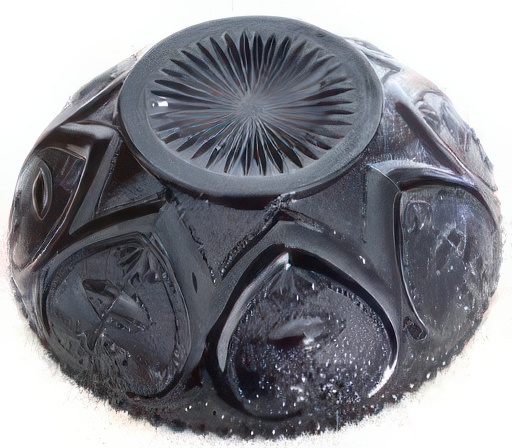Cherries/Jeweled Heart Repros
By Dr. Larry Keig
The collar-based Cherries primary pattern, with Jeweled Heart back, was among Dugan’s most popular patterns back in the early days of carnival. It was made using two molds: one for large pieces, another for the small.
The large pieces were shaped into bowls with a number of edge treatments and, as discovered recently, a chop plate. Nearly all the bowls are amethyst/purple and peach opal, although one is also known in standard green. The plate that Burns Auction sold in May 2022 is amethyst with gold iridescence.
Classic Proofs
Large Cherries/Jeweled Heart proofs were produced during the early classic era by Dugan (1909-1913). Large proofs have also been made more recently. The two versions are shaped somewhat differently, and their top diameters and heights are also a bit different. Recognizing the variability in shape and dimensions are two key ways to distinguish the old from the new, as neither is manufacturer-marked.

Old Cherries Bowl
Large classic proofs (deep rounds) are slightly over eight inches in top diameter and nearly three inches tall. Non-ruffled bowls with more expansive top diameters of eight and one-half to nine inches are likely ice creams. The angle (from base to top edge) of large classic proofs is considerably greater than the nearly right-angled small bowls. Large Cherries/J.H. proofs and ice creams have sometimes collectively beendescribed as mid-size even as they were produced from the same mold as all other large bowls.

Classic Cherries bowl with Jeweled Heart exterior with no iridescence.
The exterior sides of classic Cherries/J.H. bowls are hardly ever iridescent although there are occasional exceptions. The underside of their collar bases are never iridized. In other words, a Cherries/J.H. bowl with an iridescent base is not classic carnival.
Reproduced Proofs

Reproduction Cherries Bowl
The Cherries/Jeweled Heart reproduction is said to have been made by L.G. Wright.* This proof is a deep non-ruffled round that is noticeably different in shape from the classic proof. The top diameter of the repro is about seven and one- half inches. It stands about three and one-fourth inches tall. Its body is flared but its top edge runs nearly perpendicular to its collar base. In shape, it is similar to the master Circle Scroll bowl although not as large in diameter or as tall.

Besides the differences in size between the classic and reproduced proofs, their iridescent treatments are different. The Jeweled Heart exterior of the classic is rarely iridized and its base never iridized. By contrast, the J.H. exterior of the repro is almost always, maybe invariably, iridized. The J.H. exterior of the repro has a satin finish, the base a shiny radium iridescent treatment. The repro has been confirmed only in amethyst/ purple. It is also said to exist in electric blue but that is yet to be validated.

The Cherries interior, J.H. exterior, and rayed base of an amethyst repro are shown. Its interior iridescence has a satin finish. Its exterior iridescence has a vibrant multi- color satin finish. Its iridized base is glossy, some would say, gaudy, in appearance. This bowl sold on eBay in early 2022. It and others which have been listed recently on this platform have come from the New York City metropolitan area.
L.G. (Si) Wright was an entrepreneur in the areas of glass manufacture and distribution. At the start, he might be best described as a middleman in glass sales. In the early years, he bought “glass from the New Martinsville glass company, from Fenton Art Glass, from Cambridge Glass and other glass and [sold] it to antiques dealers and glass retailers.”** He dealt in several types of glass, not just carnival.
“From the very start in 1937, Si was ordering molds to be made for his own versions of popular Victorian patterns. He also bought some original old molds, in particular some Northwood, Dugan, and Diamond molds.” When, where, and under what circumstances he acquired the Cherries/Jeweled Heart mold and other molds crafted at the Dugan and Diamond plant in southwestern Pennsylvania remains unclear.***
Carl O. Burns described the reproduced Cherries/J.H. bowl in Dugan and Diamond Carnival Glass (1999, p. 46). Dave Doty lists and illustrates it on his website under “Contemporary Carnival Glass,” found there under “Cherries.” Elaine Blair lists it in her regularly updated table titled “Carnival Glass Reproductions.”
Elaine also lists there a reproduced plate. She has also written a thoughtful short essay on contemporary carnival. Readers who are familiar with the plate are asked to report and photograph it for an article update.
Notes
*The maker of the reproduction is not absolutely certain. While it seems likely that it was made by Wright because that firm once owned many Dugan molds, others believe the repro was a Fenton pro- duct, even if these usually have the Fenton inscription within an oval.
**Quoted material is from an unattributed internet article titled “L.G. Wright Glass: From the Glass Encyclopedia.”
***I don’t claim to know much about L.G. Wright glass so would appreciate the help of readers who know more than I to fill in details of which I am unaware and for corrections to what I have presented here.
Photos courtesy of the editor.
This article first appeared in the ICGA Pump in the June 2023 issue and is reprinted with permission.
